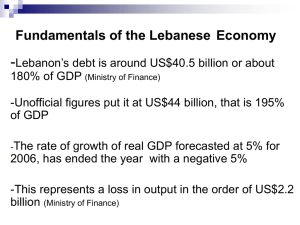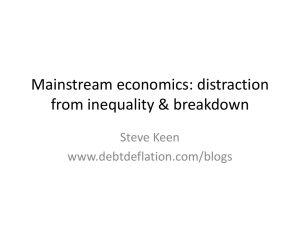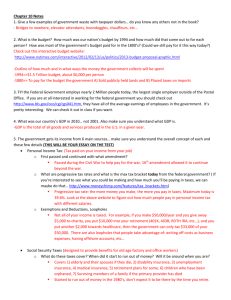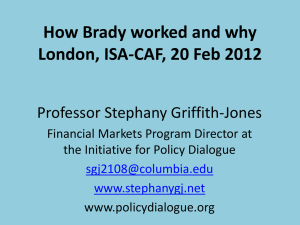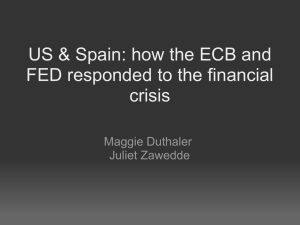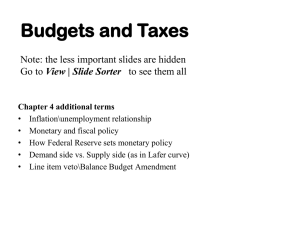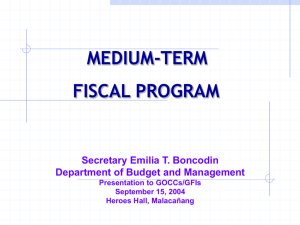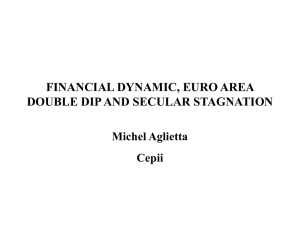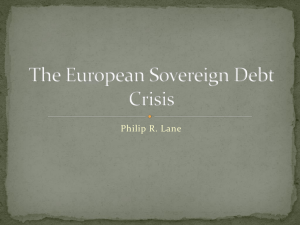Chapter 1.
advertisement
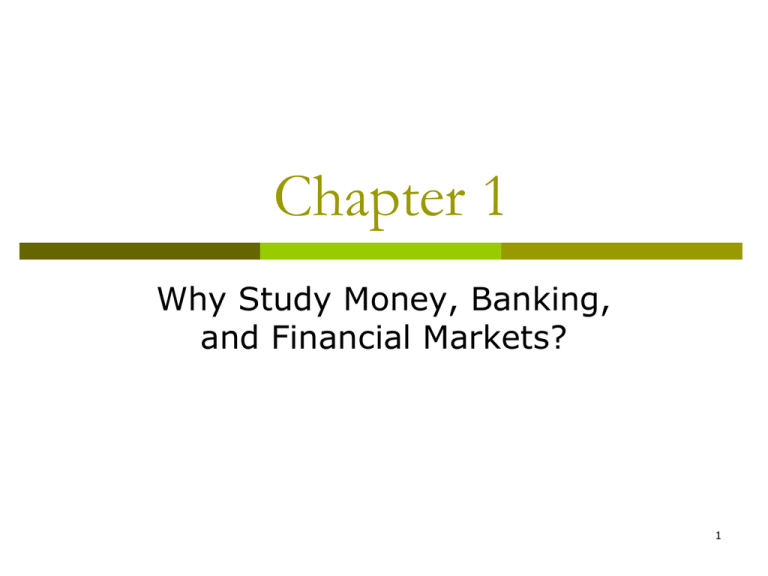
Chapter 1 Why Study Money, Banking, and Financial Markets? 1 Why Study Money, Banking, and Financial Markets To examine how financial markets such as bond, stock and foreign exchange markets work To examine how financial institutions such as banks and insurance companies work To examine the role of money in the economy 2 Financial Markets Markets in which funds are transferred from people who have an excess of available funds to people who have a shortage of funds 3 The Bond Market and Interest Rates A security is a claim on the issuer’s future income or assets A bond is a debt security that promises to make pre-determined fixed payment(s) at a specific date in future (maturity). An interest rate is the cost of borrowing or the price paid for the rental of financial capital. Currently, int. rate is 5.75% in TR. 4 5 18.01.2010 18.10.2009 18.07.2009 18.04.2009 18.01.2009 18.10.2008 18.07.2008 18.04.2008 18.01.2008 18.10.2007 18.07.2007 18.04.2007 18.01.2007 18.10.2006 18.07.2006 18.04.2006 18.01.2006 Interest Rates on Turkish TBills and Gov. Bonds simple annual int.rate 30 25 20 15 10 5 0 issue date 6 The Stock Market Common stock represents a share of ownership in a corporation A share of stock is a claim on the earnings and assets of the corporation A stock market is where stocks are traded in a “secondary market” 7 8 /M Ar on a t A r lı k h a 8 A r lı k 6 al 87 Ar ık al 88 Ar ık al 89 Ar ık al 90 Ar ık al 91 Ar ık al 92 Ar ık a 9 A r lı k 3 a 9 A r lı k 4 a 9 A r lı k 5 a 9 A r lı k 6 a 9 A r lı k 7 a 9 A r lı k 8 a 9 A r lı k 9 al 00 Ar ık al 01 Ar ık al 02 Ar ık al 03 Ar ık al 04 Ar ık al 05 ık 06 Ay ISE Stock Prices İMKB-100 / ISE-100 50,000.00 45,000.00 40,000.00 35,000.00 30,000.00 25,000.00 20,000.00 15,000.00 10,000.00 5,000.00 0.00 9 The Foreign Exchange Market The foreign exchange market is where funds are converted from one currency into another The foreign exchange rate is the price of one currency in terms of another currency. Currently, 1.77 TL / $ The foreign exchange rate is determined in the foreign exchange market. 10 02.01.2006 02.01.2002 02.01.1998 02.01.1994 02.01.1990 02.01.1986 02.01.1982 02.01.1978 02.01.1974 02.01.1970 02.01.1966 02.01.1962 02.01.1958 02.01.1954 02.01.1950 TL/$ exchange rate 10000000 1000000 100000 10000 1000 100 10 1 11 Value of Lira against Dollar See: Dolar 1950-2007.htm 1950 -1960: 2.82 TL / $ 1960 – August 1970: 9.08 TL / $ August 1970 – December 1971: 15.15 TL/$ December 1971 – May 1974: 14.30 TL / $ After 1980 variable (depreciations). 12 13 Banking and Financial Institutions Financial Intermediaries—institutions that borrow funds from people who have saved and make loans to people who need credit. Banks—institutions that accept deposits and make loans. (not all financial intermediaries accept deposits). Investment banks, insurance companies, etc. do not accept deposits. Other Financial Intermediaries—insurance companies, mortgage companies, pension funds, mutual funds and investment banks Financial Innovation—in particular, the advent of computers and internet globalized the market, sped up transactions, introduced new financial instruments. 14 Money Supply and Business Cycles Evidence suggests that money plays an important role in generating business cycles. Business cycles: Recessions (unemployment) and booms (inflation) affect all of us. 15 16 Money Supply and Inflation Monetary Theory relates changes in the money supply to changes in total output (=total income) and the price level The aggregate price level (P) is a weighted average of the prices of goods and services produced in an economy Quantity theory of money (MV = PY) suggests and empirical data shows a connection between the money supply and the price level. 17 Money supply and price level in TR 900000 800000 700000 600000 500000 M2Y (1987=100) GDP DEFLATOR (1987=100) 400000 300000 200000 100000 0 1996 1997 1998 1999 2000 2001 2002 2003 2004 18 19 Money Supply And İnflation in TR 110.00 100.00 90.00 80.00 70.00 60.00 GDP defl. Growth M2Y growth rate 50.00 40.00 30.00 20.00 10.00 0.00 1997 1998 1999 2000 2001 2002 2003 2004 20 Inflation İs The Rate Of Change of The Price Level GDP deflator vs CPI 110 100 90 80 70 60 GDPDeflator CPI 50 40 30 20 10 0 1997 1998 1999 2000 2001 2002 2003 2004 2005 21 Turkey 22 Monetary Policy and Fiscal Policy Monetary policy is the control of the money supply. It is conducted by the Central bank. CB uses interest rates and other instruments to control the money supply. The Purpose of Mon. Pol. Is to control inflation which is the rate of change of the price level. Conducted in Turkey by CBRT, In the U.S. by the Federal Reserve Bank (Fed) Why is it important to control the money supply? 23 Monetary Policy and Fiscal Policy Fiscal policy is the management of the govt. budget: government spending and taxation. Budget deficit is the excess of expenditures over revenues for a particular year Budget surplus is the excess of revenues over expenditures for a particular year Any deficit must be financed by borrowing. Before 1994, Turkish Treasury could borrow from the CB: CB printed money and lent to the govt by buying govt. bonds from Treasury. But this was abolished partially after 1994, and fully after 2001. Now CB is more independent from the govt. 24 GOVERNMENT BUDGET CONSTRAINT At any year t, govt. budget must satisfy Gt + rBt-1 = Tt + Bt-Bt-1 Gt Bt-1 rBt-1 Tt Bt-Bt-1 : govt. expenditures : govt.’s outstanding stock of debt. : interest payment on outstanding debt (r:real int. rate) : taxes (revenues) : newly issued debt during year t 25 Turkish Government’s Budget Billion TRL 2000 2001 2002 2003 2004 2005 Revenues 33.3 51.8 76.4 100.2 109.9 134.8 Tax Revenues 26.5 39.8 59.6 84.3 90.1 106.9 6.8 12.0 16.8 15.9 19.8 27.9 Expenditures 46.6 80.4 115.5 140.1 140.2 144.6 Expenditures excl. İnterest P 26.2 39.3 63.6 81.4 83.7 98.9 Interest Payments (IP) 20.4 41.1 51.9 58.6 56.5 45.7 -13.3 -28.6 -39.1 -39.8 -30.3 -9.8 7.1 12.5 12.8 18.8 26.2 35.9 -12.6 -32.1 -34.4 -41.9 -30.4 -10.4 12.8 32.1 34.4 41.9 30.4 10.4 Foreign Borrowing Net 2.7 -4.4 16.6 2.7 4.0 -1.2 Domestic Borrıowing Net 9.4 23.2 17.5 42.9 30.8 21.3 Other Financing 0.7 13.4 0.3 -3.7 -4.4 -9.7 FDF/GDP (%) 5.7 7.1 4.7 5.3 6.1 7.4 -10.6 -16.2 -14.3 -11.2 -7.1 Other Budget Balance Budget Balance excl. IP (FDF) Cash Balance Financing Budget Deficit / GDP Source: HM, http://www.mahfiegilmez.nom.tr/ -2.0 26 Turkish Government’s Budget STOCK of DEBT & DEBT/GDP (billion dollars) 2002 2009 Total public debt 151.5 301.3 Domestic public debt 94.5 227.3 Foreign public debt 56.8 74.0 Public Debt/GDP 65.7 47.8 CBRT Foreign Debt 22.0 13.6 Private sector foreign debt 43.1 176.3 Private sector foreign debt/GDP 18.7 27.0 USD Exchange rate 1.51 1.50 230.5 630.0 GDP Source: Mahfi Eğilmez, “Borcumuz Ne Kadar?” Radikal, 16 Şubat 2010 Salı 27 US Government’s Budget 28

